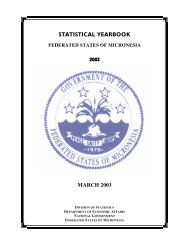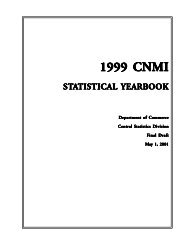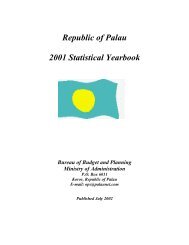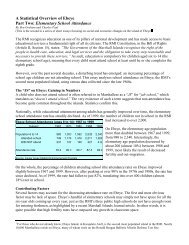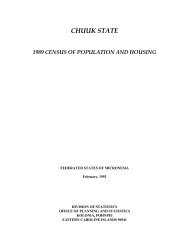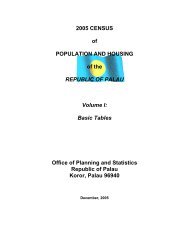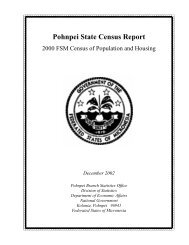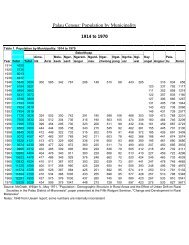Chapter 11. Income2000 FSM <strong>Census</strong> of <strong>Chuuk</strong> <strong>State</strong>The median income for individuals in <strong>Chuuk</strong> in 1999 increased steadily to the age of 49 after which income levelsbegan to decrease (Table 11.4). Age groups 45 to 49 and 50 to 54 had the highest median income. Both males andfemales tended to follow the same pattern mentioned above except that males aged 55 to 59 maintained relatively highincomes. Also females with the highest incomes include age group 45 to 49; income of older women was lower. Thispattern is perhaps, in part, due to fewer education opportunities available to the older generation of women resulting inlower earning capacities.Table 11.4: Individual Income in 1993 and 1999 by Age Group and Sex, <strong>Chuuk</strong> <strong>State</strong>: 1994 and 2000Total Males FemalesAge group No.of persons Median ($) Mean ($) No. of persons Median ($) Mean ($) No. of persons Median ($) Mean ($)1994Total 9,283 987 2,875 5,714 1,378 3,467 3,569 852 1,92815 to 19 years 683 589 526 377 598 535 306 577 51620 to 24 years 965 774 1,362 507 757 1,362 458 795 1,36225 to 29 years 1,021 912 1,820 594 955 2,027 427 857 1,53130 to 34 years 1,168 1,013 2,495 715 1,262 2,550 453 902 2,40935 to 39 years 1,284 1,736 3,182 781 2,067 3,596 503 1,237 2,53840 to 44 years 1,234 2,371 4,427 794 3,153 5,335 440 1,273 2,78945 to 49 years 896 2,294 4,863 605 2,992 5,815 291 957 2,88250 to 54 years 484 1,578 3,677 312 2,500 4,526 172 835 2,13755 to 59 years 481 1,465 3,466 327 1,894 4,098 154 963 2,12460 to 64 years 419 1,174 4,092 291 1,573 5,400 128 810 1,12065 yrs & over 648 812 1,815 411 956 2,442 237 644 7292000Total 19,090 785 2,133 10,536 888 2,672 8,554 686 1,46915 to 19 years 2,644 541 581 1,381 541 478 1,263 541 69320 to 24 years 2,506 626 975 1,406 636 937 1,100 612 1,02425 to 29 years 2,318 708 1,242 1,252 760 1,299 1,066 656 1,17530 to 34 years 2,099 825 1,895 1,196 976 2,210 903 685 1,47835 to 39 years 2,056 857 2,181 1,167 1,071 2,576 889 708 1,66340 to 44 years 1,946 1,163 3,093 1,101 1,750 3,621 845 840 2,40545 to 49 years 1,728 1,620 4,945 1,005 2,597 6,785 723 855 2,38850 to 54 years 1,232 1,350 3,342 674 2,351 4,383 558 833 2,08455 to 59 years 647 1,278 4,676 353 2,500 6,898 294 778 2,00860 to 64 years 601 1,098 2,603 315 1,933 3,780 286 786 1,30665 yrs & over 1,313 828 1,622 686 961 2,214 627 719 974Source: 1994 FSM <strong>Census</strong>, Table P31; 2000 FSM <strong>Census</strong>, Table P2-19Individual incomes varied considerably between males and females in 1999. Table 11.5 provides 2000 <strong>Census</strong> datafrom which percentages of males and females in each income range may be calculated. About 60 percent of all personsaged 15 years and over reported cash income. Close to 67 percent of the working-age males reported incomes,compared to 54 percent of the working-age females. Furthermore, the 2000 data show considerable differencesbetween males and females, by income level. More females (51.2 percent) than males (48.8 percent) were representedat the lowest income level (less than $1,000). Above the $1,000 level, males predominated at every income level,particularly for higher income levels $15,000 to $34,999 – a ratio of 3 males to 1 female. In 1999, the median incomesfor males and females were $888 and $686, respectively. The females earned only 77 percent of what the malesearned.Table 11.5: Individual Income by Sex, <strong>Chuuk</strong> <strong>State</strong>: 1994 and 20001994 2000Number Percent Number PercentAnnual income Total Males Females Total Males Females Total Males Females Total Males FemalesPersons 15+ years 29,068 14,687 14,381 100.0 50.5 49.5 31,587 15,782 15,805 100.0 50.0 50.0Persons with income 9,283 5,714 3,569 100.0 61.6 38.4 19,090 10,536 8,554 100.0 55.2 44.8Less than $ 1,000 4,701 2,607 2,094 100.0 55.5 44.5 12,163 5,930 6,233 100.0 48.8 51.2$ 1,000 to $ 1,999 1,101 661 440 100.0 60.0 40.0 2,160 1,379 781 100.0 63.8 36.2$ 2,000 to $ 2,999 888 596 292 100.0 67.1 32.9 1,180 808 372 100.0 68.5 31.5$ 3,000 to $ 3,999 588 404 184 100.0 68.7 31.3 868 572 296 100.0 65.9 34.1$ 4,000 to $ 4,999 422 288 134 100.0 68.2 31.8 597 361 236 100.0 60.5 39.5$ 5,000 to $ 7,499 770 537 233 100.0 69.7 30.3 1,044 721 323 100.0 69.1 30.9$ 5,500 to $ 9,999 321 239 82 100.0 74.5 25.5 409 301 108 100.0 73.6 26.4$10,000 to $12,499 181 128 53 100.0 70.7 29.3 247 152 95 100.0 61.5 38.5$12,500 to $14,999 70 51 19 100.0 72.9 27.1 70 51 19 100.0 72.9 27.1$15,000 to $19,999 98 80 18 100.0 81.6 18.4 94 74 20 100.0 78.7 21.3$20,000 to $24,999 61 53 8 100.0 86.9 13.1 146 109 37 100.0 74.7 25.3$25,000 to $34,999 34 28 6 100.0 82.4 17.6 60 45 15 100.0 75.0 25.0$35,000 to $49,999 25 22 3 100.0 88.0 12.0 34 22 12 100.0 64.7 35.3$50,000 or more 23 20 3 100.0 87.0 13.0 18 11 7 100.0 61.1 38.9Median (dollars) $987 $1,378 $852 ... ... ... $785 $888 $686 ... ... ...Mean (dollars) $2,875 $3,467 $1,928 ... ... ... $2,133 $2,672 $1,469 ... ... ...Source: 1994 FSM <strong>Census</strong>, Table P173; 2000 FSM <strong>Census</strong>, Table P11-1.104 <strong>Chuuk</strong> Branch Statistics Office, Division of Statistics, FSM Department of Economic Affairs
2000 FSM <strong>Census</strong> of <strong>Chuuk</strong> <strong>State</strong>Chapter 11. IncomeTable 11.6 compares income levels of female-headed households (no husband present) to married-couple families andto all families in 1999. With no exception, the median income in each region was considerably smaller for femaleheadedhouseholds than for married-couple families. This finding suggests most obviously that married-couplefamilies were more likely to have higher incomes than female-head households simply because there were moreworkers in the married-couple households. The smallest disparity of $2 between female-head households and marriedcouplefamilies was recorded in Southern Namoneas, while the largest disparity of $3,000 was recorded in the Halls.Table 11.6: Median Income in U.S. Dollars ($) by Type of Family and Region, <strong>Chuuk</strong> <strong>State</strong>: 1994 and 20001994 2000Number of families Median income ($) Number of families Median income ($)Female Female Female Femalehholdr, no hholdr, no hholdr, no hholdr, noMarried husband Married husband Married husband Married husbandRegion Total couple present Total couple present Total couple present Total couple presentTotal 4,696 3,822 510 2,327 2,580 1,103 6,211 4,751 463 2,935 2,975 2,500Lagoon 3,819 3,118 406 2,592 2,866 1,188 4,870 3,739 377 3,191 3,226 2,936N. Namoneas 1,731 1,452 160 4,952 5,343 2,636 1,826 1,376 140 4,906 5,051 3,778S. Namoneas 1,057 823 135 1,218 1,436 794 1,484 1,117 125 3,235 3,235 3,233Faichuk 1,031 843 111 952 973 816 1,560 1,246 112 1,838 1,864 1,583Outer Islands 877 704 104 1,315 1,423 929 1,341 1,012 86 1,899 1,970 956Mortlocks 553 428 80 1,000 1,020 976 812 589 58 2,254 2,353 1,500Pattiw 136 121 5 2,778 2,611 3,750 137 118 7 906 922 700Namonwito 88 66 14 1,500 2,143 583 180 135 15 962 1,060 625Halls 100 89 5 18,000 1,833 1,500 212 170 6 4,333 4,500 1,500Source: 1994 & 2000 FSM <strong>Census</strong>, unpublished dataIn general, it is expected that income increases with educational attainment (Table 11.7). The 2000 <strong>Census</strong> data disputethis generalization. A cursory review of elementary educational attainment suggests that variability is more likely. Forinstance, the over-all median income for all persons 25 years old and over with no education was $665, and withelementary 1-3 years, it was $754. The generalization seems to be proven; however, the median income for elementary4-7 ($687) was less than elementary 1-3 ($754). Again, a comparison between high school 9-11 ($675) and elementarygraduates ($705) indicates that the variability prevails.A comparison of median income between elementary graduates ($705) and high school graduates ($987) shows thatelementary graduates earned about 71 percent of the median income of high school graduates. Median income forpersons who attended some college ($1,794) was almost twice the median income of high school graduates ($987).Persons with associate degrees earned between 77 percent and 81 percent of those with bachelor’s degrees. Obviously,those with master’s degrees received significantly higher median incomes than all other lower income levels: thosewith bachelor’s degrees received 58percent of the median income of those with master’s degrees; those with associatedegrees, 45 percent to 47 percent; high school graduates, 8percent; elementary school graduates, 6percent; and thosewith no education, 5percent.The median income in 1999 for women ($686) was less than that of men ($888). What is surprising is how muchdifferent the median income was for each educational level. In general, women earned only 77.3 percent of what menearned. At most educational levels, the difference ranged from 76 percent to 87 percent; however, at two levels thepercentage differences were substantial – 43.1 percent with some college, no degree; and 54.7 percent with master’sdegree or higher. The over-all data indicate that the median incomes for both men and women increased along withlevels of educational attainment, however, median incomes were generally higher for men than women.<strong>Chuuk</strong> Branch Statistics Office, Division of Statistics, FSM Department of Economic Affairs 105
- Page 5:
iii
- Page 12 and 13:
Preface2000 FSM Census of Chuukx
- Page 14 and 15:
Table of contents2000 FSM Census of
- Page 16 and 17:
LIST OF TEXT TABLESTABLEPageChapter
- Page 18 and 19:
List of Text Table2000 FSM Census o
- Page 20 and 21:
LIST OF FIGURESFIGUREPageFigure 1.1
- Page 22 and 23:
List of Basic-Tables2000 FSM Census
- Page 24 and 25:
MAP OF FSMxxiiChuuk Branch Statisti
- Page 27 and 28:
2000 FSM Census of Chuuk StateExecu
- Page 29 and 30:
CHAPTER 1INTRODUCTIONThe creation o
- Page 31 and 32:
2000 FSM Census of Chuuk StateChapt
- Page 33 and 34:
2000 FSM Census of Chuuk StateChapt
- Page 35 and 36:
2000 FSM Census of Chuuk StateChapt
- Page 37 and 38:
2000 FSM Census of Chuuk StateChapt
- Page 39 and 40:
2000 FSM Census of Chuuk StateChapt
- Page 41 and 42:
2000 FSM Census of Chuuk StateChapt
- Page 43 and 44:
2000 FSM Census of Chuuk State Chap
- Page 45:
2000 FSM Census of Chuuk StateChapt
- Page 48 and 49:
Chapter 2. Age and Sex Structure200
- Page 50 and 51:
Chapter 2. Age and Sex Structure200
- Page 52 and 53:
Chapter 2. Age and Sex Structure200
- Page 55 and 56:
CHAPTER 3HOUSEHOLDS, FAMILIES, AND
- Page 57 and 58:
2000 FSM Census of Chuuk StateChapt
- Page 59 and 60:
2000 FSM Census of Chuuk StateChapt
- Page 61:
2000 FSM Census of Chuuk StateChapt
- Page 64 and 65:
Chapter 4. Fertility2000 FSM Census
- Page 66 and 67:
Chapter 4. Fertility2000 FSM Census
- Page 68 and 69:
Chapter 4. Fertility2000 FSM Census
- Page 71 and 72:
CHAPTER 5MORTALITYIntroductionAs re
- Page 73 and 74:
2000 FSM Census of Chuuk StateChapt
- Page 75:
2000 FSM Census of Chuuk StateChapt
- Page 78 and 79:
Chapter 6. Migration2000 FSM Census
- Page 80 and 81:
Chapter 6. Migration2000 FSM Census
- Page 82 and 83: Chapter 6. Migration2000 FSM Census
- Page 84 and 85: Chapter 6. Migration2000 FSM Census
- Page 86 and 87: Chapter 7. Religion, Ethnicity, and
- Page 88 and 89: Chapter 7. Religion, Ethnicity, and
- Page 90 and 91: Chapter 7. Religion, Ethnicity, and
- Page 92 and 93: Chapter 8. Education2000 FSM Census
- Page 94 and 95: Chapter 8. Education2000 FSM Census
- Page 96 and 97: Chapter 8. Education2000 FSM Census
- Page 98 and 99: Chapter 8. Education2000 FSM Census
- Page 100 and 101: Chapter 8. Education2000 FSM Census
- Page 103 and 104: CHAPTER 9ECONOMIC ACTIVITYIntroduct
- Page 105 and 106: 2000 FSM Census of Chuuk StateChapt
- Page 107 and 108: 2000 FSM Census of Chuuk StateChapt
- Page 109 and 110: 2000 FSM Census of Chuuk StateChapt
- Page 111 and 112: 2000 FSM Census of Chuuk StateChapt
- Page 113 and 114: 2000 FSM Census of Chuuk StateChapt
- Page 115 and 116: 2000 FSM Census of Chuuk StateChapt
- Page 117 and 118: CHAPTER 10INDUSTRY AND OCCUPATIONIn
- Page 119 and 120: 2000 FSM Census of Chuuk StateChapt
- Page 121 and 122: 2000 FSM Census of Chuuk StateChapt
- Page 123 and 124: 2000 FSM Census of Chuuk StateChapt
- Page 125 and 126: 2000 FSM Census of Chuuk StateChapt
- Page 127 and 128: 2000 FSM Census of Chuuk StateChapt
- Page 129 and 130: CHAPTER 11INCOMEIntroductionThe 200
- Page 131: 2000 FSM Census of Chuuk StateChapt
- Page 135 and 136: 2000 FSM Census of Chuuk StateChapt
- Page 137: 2000 FSM Census of Chuuk StateChapt
- Page 140 and 141: Chapter 12. Housing2000 FSM Census
- Page 142 and 143: Chapter 12. Housing2000 FSM Census
- Page 144 and 145: Chapter 12. Housing2000 FSM Census
- Page 146 and 147: Chapter 12. Housing2000 FSM Census
- Page 148 and 149: Chapter 12. Housing2000 FSM Census
- Page 150 and 151: Chapter 12. Housing2000 FSM Census
- Page 152 and 153: Chapter 12. Housing2000 FSM Census
- Page 154: Chapter 12. Housing2000 FSM Census
- Page 157 and 158: BIBLIOGRAPHYArriaga, E.E., (1983).
- Page 159: 2000 FSM Census of Chuuk StateBibli
- Page 162 and 163: Basic Tables2000 FSM Census of Chuu
- Page 164 and 165: Basic Tables2000 FSM Census of Chuu
- Page 166 and 167: Basic Tables2000 FSM Census of Chuu
- Page 168 and 169: Basic Tables2000 FSM Census of Chuu
- Page 170 and 171: Basic Tables2000 FSM Census of Chuu
- Page 172 and 173: Basic Tables2000 FSM Census of Chuu
- Page 174 and 175: Basic Tables2000 FSM Census of Chuu
- Page 176 and 177: Basic Tables2000 FSM Census of Chuu
- Page 178 and 179: Basic Tables2000 FSM Census of Chuu
- Page 180 and 181: Basic Tables2000 FSM Census of Chuu
- Page 182 and 183:
Basic Tables2000 FSM Census of Chuu
- Page 184 and 185:
Basic Tables2000 FSM Census of Chuu
- Page 186 and 187:
Basic Tables2000 FSM Census of Chuu
- Page 188 and 189:
Basic Tables2000 FSM Census of Chuu
- Page 190 and 191:
Basic Tables2000 FSM Census of Chuu
- Page 192 and 193:
Basic Tables2000 FSM Census of Chuu
- Page 194 and 195:
Basic Tables2000 FSM Census of Chuu
- Page 196 and 197:
Basic Tables2000 FSM Census of Chuu
- Page 198 and 199:
Basic Tables2000 FSM Census of Chuu
- Page 200 and 201:
Basic Tables2000 FSM Census of Chuu
- Page 202 and 203:
Basic Tables2000 FSM Census of Chuu
- Page 204 and 205:
Basic Tables2000 FSM Census of Chuu
- Page 206 and 207:
Basic Tables2000 FSM Census of Chuu
- Page 208 and 209:
Basic Tables2000 FSM Census of Chuu
- Page 210 and 211:
Basic Tables2000 FSM Census of Chuu
- Page 212 and 213:
Basic Tables2000 FSM Census of Chuu
- Page 214 and 215:
Basic Tables2000 FSM Census of Chuu
- Page 216 and 217:
Basic Tables2000 FSM Census of Chuu
- Page 218 and 219:
Basic Tables2000 FSM Census of Chuu
- Page 220 and 221:
Basic Tables2000 FSM Census of Chuu
- Page 222 and 223:
Basic Tables2000 FSM Census of Chuu
- Page 224 and 225:
Basic Tables2000 FSM Census of Chuu
- Page 226 and 227:
Basic Tables2000 FSM Census of Chuu
- Page 228 and 229:
Basic Tables2000 FSM Census of Chuu
- Page 230 and 231:
Basic Tables2000 FSM Census of Chuu
- Page 232 and 233:
Basic Tables2000 FSM Census of Chuu
- Page 234 and 235:
Basic Tables2000 FSM Census of Chuu
- Page 236 and 237:
Basic Tables2000 FSM Census of Chuu
- Page 238 and 239:
Basic Tables2000 FSM Census of Chuu
- Page 240 and 241:
Basic Tables2000 FSM Census of Chuu
- Page 242 and 243:
Basic Tables2000 FSM Census of Chuu
- Page 244 and 245:
Basic Tables2000 FSM Census of Chuu
- Page 246 and 247:
Basic Tables2000 FSM Census of Chuu
- Page 248 and 249:
Basic Tables2000 FSM Census of Chuu
- Page 250 and 251:
Basic Tables2000 FSM Census of Chuu
- Page 252 and 253:
Basic Tables2000 FSM Census of Chuu
- Page 254 and 255:
Basic Tables2000 FSM Census of Chuu
- Page 256 and 257:
Basic Tables2000 FSM Census of Chuu
- Page 258 and 259:
Basic Tables2000 FSM Census of Chuu
- Page 260 and 261:
Basic Tables2000 FSM Census of Chuu
- Page 262 and 263:
Basic Tables2000 FSM Census of Chuu
- Page 264 and 265:
Basic Tables2000 FSM Census of Chuu
- Page 266 and 267:
Basic Tables2000 FSM Census of Chuu
- Page 268 and 269:
Basic Tables2000 FSM Census of Chuu
- Page 270 and 271:
Basic Tables2000 FSM Census of Chuu
- Page 272 and 273:
Basic Tables2000 FSM Census of Chuu
- Page 274 and 275:
Basic Tables2000 FSM Census of Chuu
- Page 276 and 277:
Basic Tables2000 FSM Census of Chuu
- Page 278 and 279:
Basic Tables2000 FSM Census of Chuu
- Page 280 and 281:
Basic Tables2000 FSM Census of Chuu
- Page 282 and 283:
Basic Tables2000 FSM Census of Chuu
- Page 284 and 285:
Basic Tables2000 FSM Census of Chuu
- Page 286 and 287:
Basic Tables2000 FSM Census of Chuu
- Page 288 and 289:
Basic Tables2000 FSM Census of Chuu
- Page 290 and 291:
Basic Tables2000 FSM Census of Chuu
- Page 292 and 293:
Questionnaire2000 FSM Census of Chu
- Page 294 and 295:
Questionnaire2000 FSM Census of Chu
- Page 296 and 297:
Questionnaire2000 FSM Census of Chu



